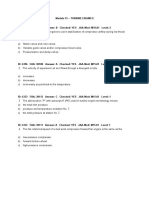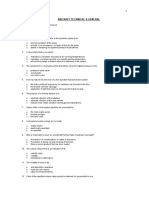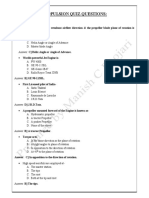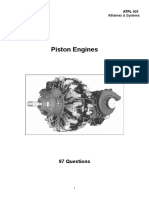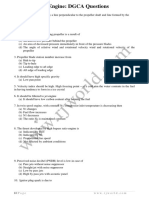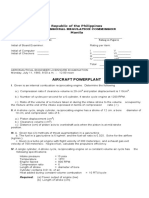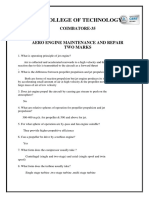Powerplant Test
Powerplant Test
Uploaded by
komilaCopyright:
Available Formats
Powerplant Test
Powerplant Test
Uploaded by
komilaOriginal Description:
Copyright
Available Formats
Share this document
Did you find this document useful?
Is this content inappropriate?
Copyright:
Available Formats
Powerplant Test
Powerplant Test
Uploaded by
komilaCopyright:
Available Formats
Name -----------------------------------------
Max Marks - 100 Time 01:00 h
TECHNICAL (G) POWERPLANT
1. The positions of the intake and exhaust valve at the end of the power stroke are :
both valves open.
both valves closed.
intake valve closed and exhaust valve open.
exhaust valve closed and intake valve open.
2. The crank assembly consists of
propeller, crankshaft, pistons and connecting rods.
Crankcase, crankshaft, connecting rods and pistons.
crankshaft, connecting rods and pistons.
crankshaft, camshaft, valves, valve springs and push rods.
3. The power of a piston engine which will be measured by using a friction brake is :
Friction horse power.
Heat loss power.
Indicated horse power.
Brake horse power.
4. A piston engine compression ratio is the ratio of the :
clearance volume to the swept volume.
total volume to the clearance volume.
total volume to the swept volume.
swept volume to the clearance volume.
5. For a given type of oil, the oil viscosity depends on the:
oil temperature.
outside pressure.
oil pressure.
quantity of oil.
6. The part of a piston engine that transforms reciprocating movement into rotary motion is termed the :
piston
crankshaft
camshaft
reduction gear
7. If the ground wire between the magnetos and the ignition switch becomes disconnected the most noticeable result
will be that:
a still operating engine will run down
the engine cannot be started with the ignition switch in the ""ON"" position
the engine cannot be shut down by turning the ignition switch to the ""OFF"" position
the power developed by the engine will be strongly reduced
8. Under normal running conditions a magneto draws primary current :
from the booster coil.
directly from the aircraft batteries.
from the aircraft batteries via an inverter.
from a self-contained electro-magnetic induction system.
RITIKESH SINGH SALHOTRA
AIRRATH AVIATION
9910592512
9. An aircraft magneto is switched off by
opening the primary circuit
grounding the primary circuit
opening the secondary circuit
grounding the secondary circuit.
10. An impulse coupling used on a magneto for a piston engine is for
providing a retarded spark for engine starting.
advancing ignition timing
quick removal and installation
absorbing starting loads
11. On modern carburettors, the variations of mixture ratios are obtained by the adjustment of :
air flow.
fuel flow and air flow.
fuel flow.
fuel flow, air flow and temperature.
12. Which statement is true concerning the effect of the application of carburettor heat?
it reduces the volume of air entering the carburettor,thus leaning the fuel/air mixture
it reduces the density of air entering the carburettor, thus leaning the fuel/air mixture
it reduces the density of air entering the carburettor, thus enriching the fuel/air mixture
it reduces the volume of air entering the carburettor,thus enriching the fuel/air mixture
13. Spark timing is related to engine speed in the way that the:
slower the engine functions, the more the spark is advanced
faster the engine functions, the further past TDC the spark occurs
faster the engine functions, the more the spark is advanced
faster the engine functions, the more retarded the spark is.
14. The operating principle of float-type carburettors is based on the:
automatic metering of air at the venturi as the aircraft gains altitude
increase in air velocity in the throat of a venturi causing an increase in air pressure
measurement of the fuel flow into the induction system
difference in air pressure at the venturi throat and the air inlet
15. Vapour lock is :
the formation of water vapour in a fuel system
vaporizing of fuel prior to reaching the carburettor
vaporizing of fuel in the carburettor
the inability of a fuel to vaporize in the carburettor
16. The kind of compressor normally used as a supercharger is :
a radial compressor.
an axial compressor.
a hybrid compressor.
a piston compressor.
17. A turbocharger consists of a :
compressor and turbine on individual shafts.
compressor driving a turbine via a reduction gear.
turbine driving a compressor via a reduction gear.
compressor and turbine mounted on a common shaft.
RITIKESH SINGH SALHOTRA
AIRRATH AVIATION
9910592512
18. The primary purpose of a supercharger is to :
increase quantity of fuel at metering jet
maintain power at altitude
provide leaner mixtures at altitudes below 5000 ft
provide a richer mixture at high altitudes
19. The octane rating of a fuel and compression ratio of a piston engine have which of the following relations?
the lower the octane rating is, the higher the possible compression ratio is
the higher the octane rating is, the higher the possible compression ratio is
the higher the octane rating is, the lower the possible compression ratio is.
compression ratio is independent of the octane rating.
20. Max. Exhaust Gas Temperature is theoretically associated with :
Mass ratio of 1/15.
Cruising mixture setting.
Full rich setting.
Mixture ratio very close to idle cut-out.
21. Specific fuel consumption is defined as the :
designed fuel consumption for a given rpm.
quantity of fuel required to run the engine for one minute at maximum operating conditions.
mass of fuel required to produce unit power for unit time.
maximum fuel consumption of the aircraft.
22. The pitch angle of a constant-speed propeller
increases with increasing true air speed.
only varies with engine RPM.
decreases with increasing true air speed.
is independent of the true air speed.
23. In a piston engine if the ratio of air to fuel, by weight, is approximately 9:1, the mixture is said to be :
weak
too weak to support combustion
rich
normal
24. In twin-engine aeroplanes with right turning propellers
the left engine produces a higher yaw moment if the right engine fails than vice versa.
the 'minimum control speed' is determined by the failure of the right engine.
the left engine is the critical motor.
the right engine is the critical motor.
25. During climb with constant throttle and RPM lever setting (mixture being constant) the :
Manifold Air Pressure (MAP) decreases.
RPM decreases.
Manifold Air Pressure (MAP) increases.
RPM increases.
26. Pre-ignition refers to the condition that may arise when :
the mixture is ignited before the piston has reached top dead centre.
a rich mixture is ignited by the sparking plugs.
the sparking plug ignites the mixture too early.
the mixture is ignited by abnormal conditions within the cylinder before the spark occurs at the plug
27. In a turbo-jet, the purpose of the turbine is to ...
RITIKESH SINGH SALHOTRA
AIRRATH AVIATION
9910592512
drive the compressor by using part of the energy from the exhaust gases
clear the burnt gases, the expansion of which provide the thrust
compress the air in order to provide a better charge of the combustion chamber
drive devices like pumps, regulator, generator.
28. The compressor surge effect during acceleration is prevented by the :
inlet guide vanes.
surge bleed valves.
Fuel Control Unit (F.C.U.).
variable setting type nozzle guide vanes.
29. The fan in a high by-pass ratio turbo-jet engine produces:
half the thrust.
the lesser part of the thrust.
the greater part of the thrust.
none of the thrust.
30. In a compressor stage of a jet engine, the sequence is:
stator - rotor
rotor - rotor - stator
rotor - stator
stator - stator – rotor
31. In a gas turbine engine, compressor blades, which are not rigidly fixed in position when the engine is stationary,
take up a rigid position when the engine is running due to :
oil pressure.
thermal expansion.
blade creep.
the resultant of aerodynamic and centrifugal forces.
32. In a gas turbine engine, the maximum gas temperature is attained:
across the turbine.
in the cooling airflow around the flame tube.
within the combustion chamber.
at the entry to the exhaust unit.
33. The primary reason for a limitation being imposed on the temperature of gas flow is to :
prevent damage to the jet pipe from overheating.
prevent overheating and subsequent creep of the nozzle guide vanes.
ensure that the maximum acceptable temperature at the turbine blades is not exceeded.
ensure that the maximum acceptable temperature within the combustion chamber is not
exceeded.
34. Turbine blade stages may be classed as either ""impulse"" or ""reaction"". In an impulse blade section
the pressure drops across the nozzle guide vanes and remains constant across the rotor blades .
the pressure rises across the nozzle guide vanes and remains constant across the rotor blades .
the pressure remains constant across the nozzle guide vanes and drops across the rotor blades .
the pressure remains constant across the nozzle guide vanes and rises constant across the rotor
blades .
35. A ""fan"" stage of a ducted-fan turbine engine is driven by:
the high pressure compressor through reduction gearing.
the high pressure turbine.
airflow drawn across it by the high pressure compressor.
RITIKESH SINGH SALHOTRA
AIRRATH AVIATION
9910592512
the low pressure turbine.
36. Using compressor bleed air to power systems:
decreases aircraft performance
has no influence on aircraft performance
increases aircraft performance
is limited to the phases of take-off and landing
37. If air is tapped from a gas turbine HP compressor, the effect on the engine pressure ratio (EPR) and the exhaust
gas temperature (EGT) is that :
both EPR and EGT decrease.
EPR decreases and EGT remains constant.
EPR decreases and EGT increases.
EPR remains constant and EGT increases.
38. In a gas turbine engine, the power changes are normally made by controlling the amount of:
air entering the compressor.
air leaving the compressor by the opening or closing of bleed valves.
fuel supplied.
air entering the compressor and fuel entering the combustion chambers.
39. The reason for having a low pressure fuel-cooled oil cooler in a recirculatory type oil system is to:
cool the oil only.
cool both the oil and the fuel.
cool the oil and heat the fuel.
heat the fuel only.
40. On the ground, the Auxiliary Power Unit (APU) can be substituted for the:
ground power unit, the air conditioning unit.
ground power unit, the starting system.
ground power unit, the starting system, the air conditioning unit.
ground power unit.
41. In addition to fire detention/protection, most auxiliary power units (APUs) have automatic controls for stating,
stopping and maintaining operation within safe limits. These controls provide correct sequencing of the starting
cycle as well as protection against :
high TGT and loss of oil pressure only.
overspeed and high oil temperature only.
high turbine gas temperature (TGT), overspeed, loss of oil pressure and high oil temperature.
high TGT only.
42. The purpose of the barometric correction in a fuel controller is to:
maintain the correct weight fuel to air ratio when the altitude increases.
reduce the fuel-to-air ratio when altitude increases.
increase the fuel-to-air ratio when altitude increases.
maintain a constant fuel metering whatever the altitude.
43. The use of igniters is necessary on a turbo-jet:1 - throughout the operating range of the engine2 - for
accelerations3 - for ground starts4 - for in-flight relights5 - during turbulence in flight6 - under heavy precipitation
or in icing conditionsThe combination which regroups all of the correct statements is :
3-4-5-6
3
2-3-4
1
RITIKESH SINGH SALHOTRA
AIRRATH AVIATION
9910592512
44. A ""hung start"" is the failure of an engine to accelerate to its normal idle speed. It may be caused by:
compressor surging.
the starter cutting out early in the starting sequence before the engine has accelerated to the an
attempt to ignite the fuel before the engine has been accelerated sufficiently by the starter.
required rpm for ignition.
failure of the fuel to ignite in the starting sequence after the engine has been accelerated to the
required rpm by the starter.
45. For a turbine engine, the term self-sustaining speed relates to the speed at which the engine :
is designed to idle after starting.
operates most efficiently in the cruise..
will enable the generators to supply bus-bar voltage.
will run without any external assistance.
46. A reverse thrust door warning light on the flight deck instrument panel illuminates when:
the reverser doors are locked.
reverse has been selected but the doors have remained locked.
the reverser doors are unlocked.
the reverser doors have moved to the reverse thrust position.
47. Concerning the centrifugal compressor, the compressor diffuser is a device in which the:
pressure rises and velocity falls.
pressure rises at a constant velocity.
velocity, pressure and temperature rise.
velocity rises and pressure falls.
48. The primary purpose of the bleed valves fitted to axial flow compressors is to :
control the acceleration time of the engine.
spill compressor air should the engine overspeed thus controlling the speed.
reduce the likelihood of compressor stall.
enable an external air supply to spin up the compressor for engine starting.
49. In a single spool gas turbine engine, the compressor rpm is :
independent of turbine rpm.
greater than turbine rpm.
the same as turbine rpm.
less than turbine rpm.
50. When changing power on engines equipped with constant-speed propeller, engine overload is avoided by :
adjusting Fuel Flow before the manifold pressure.
reducing the RPM before reducing the manifold pressure.
increasing the RPM before increasing the manifold pressure.
increasing the manifold pressure before increasing the RPM.
RITIKESH SINGH SALHOTRA
AIRRATH AVIATION
9910592512
You might also like
- 82497524-2-ADM2-FRO (1) Mercedez PDFDocument155 pages82497524-2-ADM2-FRO (1) Mercedez PDFAndre VP100% (3)
- Audi A6 Electrical Wiring Manual: Available January 2003Document1 pageAudi A6 Electrical Wiring Manual: Available January 2003tonifausnNo ratings yet
- Spareparts List: Electric Pallet Truck EPT15Document67 pagesSpareparts List: Electric Pallet Truck EPT15gargi yesareNo ratings yet
- Assesment Exam (Powerplant)Document18 pagesAssesment Exam (Powerplant)Sealtiel1020No ratings yet
- CAIP Vol II PropellersDocument32 pagesCAIP Vol II PropellersSHM 555No ratings yet
- Propulsion EASA MOD 14Document1 pagePropulsion EASA MOD 14Navaraj Baniya0% (1)
- Steady Aircraft Flight and PerformanceFrom EverandSteady Aircraft Flight and PerformanceRating: 5 out of 5 stars5/5 (2)
- Volkswagen Passat 1 8tsi Leaflet WM PDFDocument2 pagesVolkswagen Passat 1 8tsi Leaflet WM PDFDavid PalashNo ratings yet
- Airframe and Powerplant ReviewerDocument45 pagesAirframe and Powerplant ReviewerBobby SereNo ratings yet
- Reviewer 5Document59 pagesReviewer 5KleberNo ratings yet
- Amte 128Document24 pagesAmte 128Jan Patrick VelosoNo ratings yet
- Module 3 IC EnginesDocument70 pagesModule 3 IC EnginesAnkitNo ratings yet
- Aircraft Technical & GeneralDocument10 pagesAircraft Technical & GeneralRaveena SharmaNo ratings yet
- Piston EngineDocument6 pagesPiston Enginerashmiame100% (2)
- AE 214 Prelim Learning Module No. 2Document24 pagesAE 214 Prelim Learning Module No. 2kira arashiNo ratings yet
- Hydraulic and Pneumatic Power Systems FAA Questions (A8)Document6 pagesHydraulic and Pneumatic Power Systems FAA Questions (A8)ajrio1785No ratings yet
- Test Paper 1Document16 pagesTest Paper 1tanmayNo ratings yet
- Propulsion Quiz QuestionsDocument2 pagesPropulsion Quiz QuestionsMANISH C POOJARINo ratings yet
- MODULE 15 PART-4 QuestionsDocument46 pagesMODULE 15 PART-4 QuestionsSam Sir100% (1)
- Fuel Injection & TurbochargingDocument4 pagesFuel Injection & Turbocharging6 avinashNo ratings yet
- 4.5 Tail Geometry and ArrangmentDocument5 pages4.5 Tail Geometry and ArrangmentpttcnNo ratings yet
- M7 Caas 1808Document5 pagesM7 Caas 1808Asal BolejNo ratings yet
- Aircraft Construction and Repair Chap.2Document8 pagesAircraft Construction and Repair Chap.2Yenoh SisoNo ratings yet
- Turbine1 FinalDocument7 pagesTurbine1 Finalmohd shahir100% (2)
- IC EnginesDocument14 pagesIC EnginesPradeep N B100% (1)
- JET & PISTON March 2020Document12 pagesJET & PISTON March 2020Agastya TandonNo ratings yet
- Piston TestDocument5 pagesPiston TestSamarth SNo ratings yet
- Aircraft Powerplant Set A (2013) - Engr - ReyesDocument6 pagesAircraft Powerplant Set A (2013) - Engr - ReyesJohn Albert FelicesNo ratings yet
- AE 2304 Propulsion II 2 Marks PDFDocument13 pagesAE 2304 Propulsion II 2 Marks PDFvaskaneNo ratings yet
- 4-Turbine Engine OperationDocument13 pages4-Turbine Engine OperationMaintenance PSINo ratings yet
- Mod 17 MCQ June 2010Document12 pagesMod 17 MCQ June 2010Shrawan Shrestha100% (2)
- Helicopter Aerodynamics From M8Document18 pagesHelicopter Aerodynamics From M8REZA TAJBAKHSHNo ratings yet
- Lubrication System Maintenance2Document37 pagesLubrication System Maintenance2Zalmiers SarterezNo ratings yet
- Engine Essay QuestionDocument7 pagesEngine Essay QuestionFikri MohamadNo ratings yet
- Chapter III Propulsion Systems Thrust and Performance ParametersDocument29 pagesChapter III Propulsion Systems Thrust and Performance ParametersshmyeNo ratings yet
- Propeller MaintainanceDocument9 pagesPropeller Maintainancejacob ellyNo ratings yet
- Dgca Module 15 Part 4Document19 pagesDgca Module 15 Part 4Sky PatelNo ratings yet
- AC Knowedge 3 146questions +answersDocument20 pagesAC Knowedge 3 146questions +answersmoik ojooNo ratings yet
- @VSN - &tar - Boy M17Document35 pages@VSN - &tar - Boy M17Vaibhav nishantNo ratings yet
- R-11 Turbojet Engine Specification: ConstructionDocument2 pagesR-11 Turbojet Engine Specification: ConstructionmauryapiaeNo ratings yet
- Piston Engines: 97 QuestionsDocument19 pagesPiston Engines: 97 QuestionsamilaNo ratings yet
- NR 322106 Aircraft Design PracticeDocument8 pagesNR 322106 Aircraft Design PracticeSrinivasa Rao GNo ratings yet
- Airman Knowledge Test Qs With AnswersDocument48 pagesAirman Knowledge Test Qs With AnswersSharat Jha0% (1)
- Aerodynamics QuizDocument4 pagesAerodynamics QuizMathew RobersonNo ratings yet
- Aero Engine Maintenance and RepairDocument21 pagesAero Engine Maintenance and RepairDurai Raj KumarNo ratings yet
- Aircraft Technical General Assessment QuizDocument6 pagesAircraft Technical General Assessment Quizstan_gatei100% (1)
- Module 14 Propulsion Notes-3 PDFDocument5 pagesModule 14 Propulsion Notes-3 PDFastikNo ratings yet
- Jet Engine DGCA QuestionsDocument6 pagesJet Engine DGCA Questionspankajmankotia100% (1)
- PRC - Aircraft PowerplantDocument24 pagesPRC - Aircraft PowerplantMommyPokaNo ratings yet
- Thrust AugmentationDocument16 pagesThrust AugmentationSenthamil Arasan0% (1)
- Jawaban PropulsiDocument35 pagesJawaban PropulsiyandaNo ratings yet
- Jet - Engine DGCA QuestionsDocument6 pagesJet - Engine DGCA Questionsstuartb4uNo ratings yet
- Module Exam Application Form PDFDocument10 pagesModule Exam Application Form PDFBazli UmarNo ratings yet
- PTC B1.1 Notes - Sub Module 17.1 (Fundamentals)Document44 pagesPTC B1.1 Notes - Sub Module 17.1 (Fundamentals)DrAmir AhmedNo ratings yet
- Aerodynamics Chapter 1 RDocument25 pagesAerodynamics Chapter 1 RYadana1No ratings yet
- Piston EngineDocument6 pagesPiston EngineanandNo ratings yet
- CH 01 Propul ThermoDocument16 pagesCH 01 Propul ThermoWilliams LabeNo ratings yet
- Aerodynamics (2013) - Engr RenigenDocument5 pagesAerodynamics (2013) - Engr RenigenReem RodriguezNo ratings yet
- Prepared by P.Senthamil Selvan.B.E., Whatsapp - 9677736267 Physics of AtmosphereDocument10 pagesPrepared by P.Senthamil Selvan.B.E., Whatsapp - 9677736267 Physics of Atmosphereshubham RahateNo ratings yet
- Module17-Propeller - 108Document13 pagesModule17-Propeller - 108Duy Khanh NguyễnNo ratings yet
- Propulsion and Fuel System IntegrationDocument36 pagesPropulsion and Fuel System IntegrationNouman Nadeem0% (1)
- Aircraft Design QuestionsDocument2 pagesAircraft Design QuestionsVijay Gorfad100% (2)
- Aemr Two MarksDocument11 pagesAemr Two MarksRajashree VenugopalNo ratings yet
- Purosangue 2Document14 pagesPurosangue 2Tarek AlsalahNo ratings yet
- CCFJ30J W TD226B 3Document2 pagesCCFJ30J W TD226B 3argodumilahNo ratings yet
- Literature Review Presentation: Submitted As A Research Proposal ForDocument21 pagesLiterature Review Presentation: Submitted As A Research Proposal Fordheerajrajkaushik19No ratings yet
- Loading Sheet LMFDocument20 pagesLoading Sheet LMFJoseph ManzunguNo ratings yet
- Application ChartDocument16 pagesApplication ChartGreisy Rosado de Rosas100% (1)
- Irp AcDocument2 pagesIrp Acjpharley603No ratings yet
- Coduri Piese Suzuki Ignis 1.2i HybridDocument16 pagesCoduri Piese Suzuki Ignis 1.2i HybridStefan Cel MareNo ratings yet
- Machine Serial Number IdentificationDocument7 pagesMachine Serial Number Identificationعقيد السبئيNo ratings yet
- Module 2Document33 pagesModule 2HimanshuNo ratings yet
- UntitledDocument36 pagesUntitledLeif KnudsenNo ratings yet
- Orient UNB Takful PJSC: Al Futtaim Protect+Document22 pagesOrient UNB Takful PJSC: Al Futtaim Protect+rangaNo ratings yet
- 2588Document3 pages2588Badia MudhishNo ratings yet
- Specs Chevrolet S10Document2 pagesSpecs Chevrolet S10Maxi Sardi100% (1)
- Hyperloop Transportation TechnologyDocument14 pagesHyperloop Transportation Technologyprakashhadule2000No ratings yet
- EMBDocument17 pagesEMBVenkatesh VenkyNo ratings yet
- Doosan S140LCV Hydraulic ExcavatorDocument3 pagesDoosan S140LCV Hydraulic ExcavatorDidik HartadiNo ratings yet
- Road Vehicle Modification HandbookDocument23 pagesRoad Vehicle Modification Handbookmagicmuffins.69erNo ratings yet
- 2021 Mazda CX-5 Owner's Manual - Mazda CanadaDocument5 pages2021 Mazda CX-5 Owner's Manual - Mazda CanadabobapostolNo ratings yet
- Automatic Transaxle1 PDFDocument2 pagesAutomatic Transaxle1 PDFluisNo ratings yet
- Programa de Mantenimiento RodilloDocument2 pagesPrograma de Mantenimiento Rodillohugo luna100% (2)
- Corratec - Allroad GeometriaDocument2 pagesCorratec - Allroad GeometriaPedro Paulo MenezesNo ratings yet
- 5019669-Yamaha Grizzly Atv 450 4x4 Owners Manual Yfm45fgDocument176 pages5019669-Yamaha Grizzly Atv 450 4x4 Owners Manual Yfm45fgJose VeraNo ratings yet
- AbsDocument11 pagesAbsDayro GeneyNo ratings yet
- Police Log March 10, 2016Document15 pagesPolice Log March 10, 2016MansfieldMAPoliceNo ratings yet
- LV18 - Braking Systems (1) - Issue 1Document63 pagesLV18 - Braking Systems (1) - Issue 1Đức HòangNo ratings yet
- B16,18,20X-7 Sb1189e00Document472 pagesB16,18,20X-7 Sb1189e00Ricardo VieiraNo ratings yet









